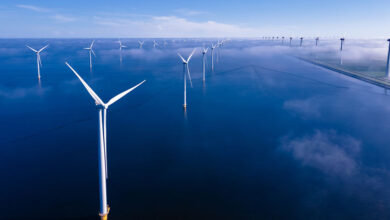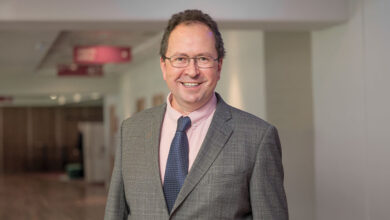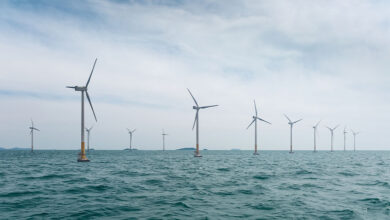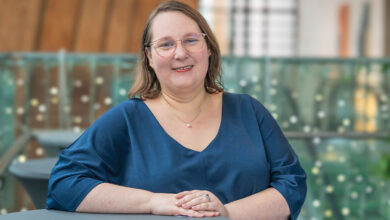Doubling carbon reduction ambitions
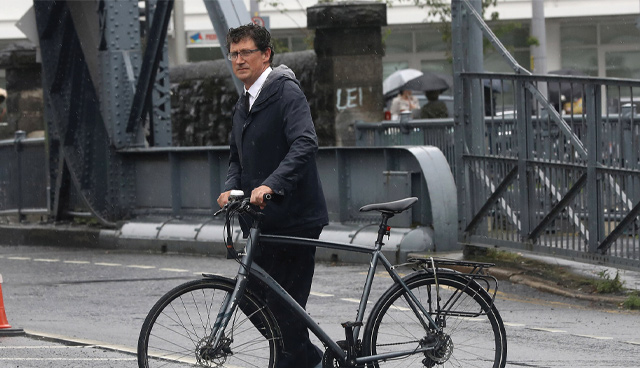
Minister for Environment, Climate Action and Communications, Eamon Ryan TD, outlines progress on the Government’s plans to double its carbon emission reduction targets to 7 per cent over the next decade.
Setting the context for the “historic need for change” in Ireland, Minister Ryan says that as the fifth anniversary of the Paris Climate Accord approaches, it’s important to remember the provision within the accord for countries to “review progress, raise ambitions and outline an enhanced path to meet the objective of trying to keep global temperature increase below an average of 1.5oC”, within those five years.
“It’s a challenge beyond compare,” states the Minister, setting out that Ireland is committed to doing this as a country within the European Union and in co-operation with the wider world.
Outlining the context in which Ireland has set its ambitions, the Minister says that the recent decision by the Chinese Government to enhance their ambition does not just boost the likelihood of achieving the global temperature goal but also provides “real certainty” that this is where the modern economy is heading and where competition is going to take place.
Additionally, Ryan says he has been encouraged by the European Commission President Ursula von der Leyen’s decision to set an ambition of a 55 per cent reduction of emissions by 2030. “I hope under the German presidency we can commit to net zero carbon neutral by 2050, which is the very latest we need to do it if we are to meet those climate targets.
“I mention the wider context because it puts in frame what we’re doing or trying to do in Ireland,” states the Minister. “We’re on a good path in terms of getting the governance right, starting with the Citizens’ Assembly asking the right question: ‘How could we be leaders rather than laggards on climate?’
“I think we did better again when we set up the Joint Oireachtas Climate Committee in the last Dáil, which looked at the findings of the Citizens’ Assembly and assessed what these meant in practice and what we would need to do. The then-Minister Richard Bruton did a really good job to turn that into a Climate Action Plan
“Now, this government is saying we need to take that and do more. We need to double the level of ambition to go from not just a 3.5 per cent cut of emissions but to go for a 7 per cent cut on average over the next decade.”
Outlining the scale of this challenge, the Minister believes that it is one “far greater” than that of the EU’s, as Ireland is starting from a lower base.
Recounting a recent meeting with the European Commission’s Vice President Frans Timmermans, Ryan says that he agreed with the Vice President’s assessment that those countries who are most ambitious in decarbonisation are the ones who will gain the most economic advantage and therefore lower the cost of the transition.
“Another thing he said, which I believe to be critically true, is that there will be no transition unless it is a just transition. We have to do this at speed, but we also have to bring our people with us. To do that we have to ensure that we eradicate fuel poverty at the same time that we eradicate pollutions and emissions from our energy mix.”
Progress
Setting out the pathways to achieving this, the Minister says that governance is important for setting a stable planning environment. Additionally, a stable political and policy environment gives people in the industry certainty that this is the right investment to make.
“We’re introducing a new Climate Bill, amending the 2015 Act, which puts in place a stronger Climate Advisory Council and a stronger planning and policy process towards meeting this new target of net zero carbon,” explains Ryan.
“It will do so by setting three five-year plans, which the Climate Advisory Council will budget and present their outline. We the Government will work with the Joint Oireachtas Committee to assess those and I will be working with each of the sectoral ministers in each of the different areas to see how we do it and hopefully, out of that process, we agree these budgets and we set ourselves on the course.”
Ryan says that while the timeline is tight, he hopes the Bill will be legislated for by December, the five-year anniversary of the Paris Climate Accord.
He adds: “We’ll then have to enhance and give additional resources to the Climate Advisory Council and to my own department to do the modelling, planning and budgeting work to actually start drafting this plan.”
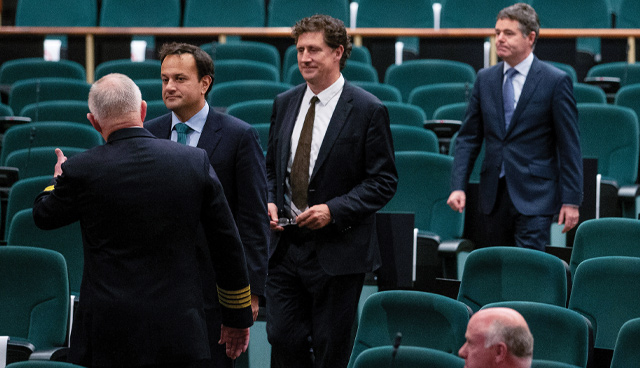
At the same time, the European Union will be legislating for a similar target. Having recently published their own impact statement on how they believe it will work on a Europe-wide basis, the EU says that it will work with individual countries as to how to do that at a local level.
“We’re starting on a good track,” states Ryan, pointing to political agreement across all parties of the need for 70 per cent renewable electricity on the system by 2030 to help meet the overall target.
“That’s a hugely challenging and demanding task and we will be testing the edge of the envelope of what’s possible, but we have real capability. EirGrid and others have real skills. The developers in this country, in this area, know how to do it and by doing it, we will learn expertise that we can share and sell to the rest of the world.”
The Minister says that progress can be recognised in the success of September’s Renewable Electricity Support Scheme (RESS) auction, where 82 renewable projects were successful, including almost 800MW of solar farms, which are being rolled out at scale for the first time.
“Critically, within that we started the auction for community energy projects, only seven of them, but I think that sets a course of where we need to go further in future. Future auctions will very much concentrate and try to support that community ownership development because it’s vital that if we are to have this as a just transition that we’ve got public support for what we have to do.”
Turning to the range of work that needs to be done by his department to help make the job of meeting the target easier, Ryan says: “I want to see the wind energy guidelines agreed with my colleagues in government before the end of the year. We need that because what we are seeing is some of the ways we can bring down the costs in our system are offering greater certainty on the planning side.
“That will be good for local communities as well,” the Minister says, pointing to the potential detrimental impact of legal challenges. “It’s better for us to have the standards right, to have certainty and to then actually get on with the job. And, particularly working with local communities, to make sure they are a part of our overall approach.”
The Minister says that another key element which will also reduce costs is the development of the electricity grid. “We’re starting to see already, even with the levels of renewables that we have now, that the levels of constraint and curtailment is making projects less economic and pushing up costs,” he explains.
Distribution
The Minister emphasises that alongside building out the grid, Ireland must continue to invest and build in enabling large infrastructure projects, such as the North South Interconnector, but also bring that investment back to a local level.
“We need to advance and invest in our distribution grid, as well as our transmission grid, so that we actually get good at the balancing of this renewable power supply to make this revolution work,” he explains.
“That’s the heart of the change happening. It’s the efficiency side, the demand management side, which is just as important as the generation side, particularly as we move to electrifying our transport and heating systems, as well as our industry systems.”
The Minister says advancement of the distribution grid will not be possible if there is no sophistication around the balancing of supply and demand. This, he adds, will offer the essential requirement to develop microgeneration.
“The old adage that microgeneration won’t be manageable on the distribution grid is no longer true,” he states. “Microgeneration will actually help strengthen the grid by using power at a local level and by giving capability to send and export power two ways, so that it actually does balance together.”
Retrofit and offshore wind
Turning to two major projects which the government are committed to progressing. Ryan points to the ambition to deep retrofit around 50,000 homes annually, which he says will deliver huge benefits in job creation and increased health and wellbeing.
Investment in retrofitting, announced in the Government’s July stimulus plan will “get us away from the start stop nature of that industry in recent years”, he says. Additionally, Budget 2021 saw the launch of the national retrofit programme through SEAI with a significant scaling up and streamlining of retrofit programmes for homes and communities. The €221 million allocation for homes and community retrofits represented an 82 per cent increase on the 2020 Budget.
Ryan also points to plans to introduce a major retrofitting scheme by late this year/early next year to set out how they are going to work with local authorities to release funding for their ability to retrofit social homes.
Another project pointed to by Ryan which he believes is critical to the “economic development” of Ireland in the coming decades is the development of offshore wind. The Programme for Government has set a target of 5GW of wind power in the Irish Sea by 2030 and 30GW of floating offshore wind on the west, north west and south west of the country in the subsequent decade and beyond.
Ryan believes that that those ambitions can be delivered in an even quicker time than set out in the Programme for Government. He plans to launch an auction system towards the end of 2021 on some of the offshore farm development plans within the Irish Sea. However, he admits that development of the west coast will require long-term planning but says that built up experience over the past decade is a solid basis for making it happen.
Ryan admits that for progress, much needs to be done in this area. “We need to develop port facilities to be able to service that,” he states, adding: “We will also need to continue to interconnect with our neighbours, both the UK and France and beyond, so that we’re part of a north west European electricity market for this to work. No matter what happens with Brexit, we will need cooperate with the UK. If they opt for an isolated energy system it would be incredibly expensive and not in their interest, not in our interest or in the interest of Europe.
“So, whatever happens in the Brexit talks, I’m committed to try to work to try and maintain that sort of cooperation in the coming years.”
Concluding, the Minister points back to the last time he held the energy portfolio, when scepticism existed around meeting the renewable electricity target of 40 per cent per annum and the economic damage striving for this might cause.
“The exact opposite was the case. We’re meeting that target, we’re benefitting from that power and we have a comparative competitive advantage and skills in this green new economy.
“We’re going to meet the 70 per cent target and be really good, in particular, on the demand side, combining the digital revolution with the energy revolution that is taking place. This is an opportunity that is available to all of us and should be seized upon not just because it is economically good and good for jobs but because it is the key project to protect our planet and our people into the future.”

